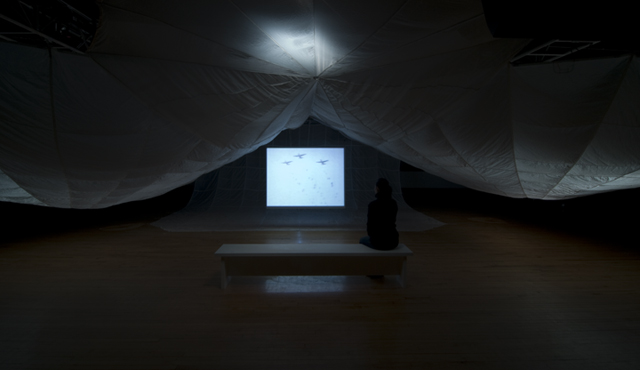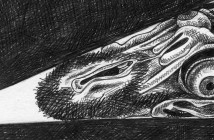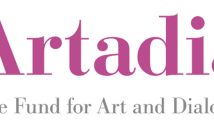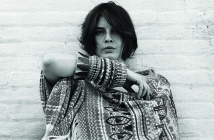Owing to the limitations inherent in print publications, time-based works often have been shortchanged in the art publishing world. Represented in photographs, video, installation art, and performance-based works are stripped of much of their essence—sound, duration, motion. Sound works without a strong visual component tend to be ignored altogether, or find themselves translated into descriptive texts. Space, scent, tactility, still cannot be reproduced, thankfully, since it is important to remember the crucial place of site, moment, one's body, one's subjectivity. Yet everything has changed with the advent of web-based journals and magazines, where the audiovisual seamlessly coexists with still images and the written word, and is even sought after given the added opportunity for more dynamic content and audience interactivity.
In this era then, the dvd-magazine ASPECT: The Chronicle of New Media Art, found it could proudly bow out, having successfully concluded a decade of cutting edge programming. Advocating for a new model of art publishing, it served as a necessary technological stop-gap in the transition between a predominately print-based world and the arrival of digital media platforms which could handle high-speed streaming, and high-definition image quality. In its 10 years and its 21 biannual issues, ASPECT succeeded in documenting myriad practices by artists from around the globe. It validated these works by curating them in volumes and distributing them to the public. It paid attention to the physical context of an artwork by highlighting sound, video, and sculptural installation, and performance art, as much as moving image works.
Founded and published by Michael Mittelman, and edited jointly with Liz Nofziger, ASPECT's approach was straightforward and thorough. A call for video submissions, usually along a given theme, was followed by a careful selection of works, which never neglected the Greater Boston community, even in this last issue, while garnering work by internationally recognized artists. The more traditional magazine component came in the form of audio commentary tracks that overlaid each video, offering the viewer the option of watching the work with or without the thoughts of a third party, chosen by the artist. This provided each artist with an opportunity for peer-review by critics, historians, curators, and the like, who brought additional context and analysis to the work.
Volume 21: A Good Place to Stop features pieces by Alicia Eggert & Alexander Reben, Jonathan Gitelson, Aaron Koblin & Chris Milk, Larson & Shindelman, Carolyn Shadid Lewis, Kayo Nakamura & J.R. Uretsky, Bogdan Perzynski, and Pilvi Takala. Ostensibly there is no theme to this last volume, but several of the chosen works—namely The Quitter, and Pulse Machine, the standout of the issue, in my opinion—directly address endings.
Alicia Eggert & Alexander Reben, Pulse Machine (excerpt)
Pulse Machine (2012) stands out not because the work itself is so much stronger than the others featured in the Volume, but because the document ventures beyond the original object and uses the video medium to bring additional context and meaning to the piece. Foremost a kinetic sound sculpture, the Pulse Machine is a bass drum hooked via an Arduino controller to a clock which will count down the seconds of an average human lifespan, then stop. The drum beats like a heart; the clock ticks like a bomb. Through a sequence of exquisitely composed shots, impeccable sound editing, and a surprising twist at its conclusion (which I won't divulge!), the documentation transforms the sculpture into a tense and symbolically charged video.
Jonathan Gitelson's The Quitter, (1999-2005) questions the accuracy of the document, and considers the ritualistic aspect of recording certain acts to mark endings. The quitter in this case is Gitelson himself, who, in a play on words, records himself quitting smoking twice (in 1999 and 2005, respectively), pointing to the fact that in the interim between each video, he quit quitting smoking. "My last cigarette" 1999 and 2005, sit side by side on the screen. In the more recent record, the artist has recreated a similar scene to stage the final act, in an armchair, backed by books. The 2005 video appears to have been sped up in order to match the running time of the 1999 event, a choice I question because it removes some of the individual authenticity of the act (the fact that he smokes more slowly in '05 than in '99, for instance), and undermines the durational qualities of the piece Dina Deitsch points to in her audio-commentary. It lends the image an anxious, hiccupy, slightly comical pace, as it tries to keep up.
Real Snow White, (2009) is the video document of a happening outside EuroDisney. Pilvi Takala, clad head-to-toe in a Snow White costume, arrives at the Park's gates, gets thronged by pipsqueak fans and their impatient parents, and is finally escorted away by security guards who pretext that, given her age, she could be confused with the "real" Snow White inside. Takala plays the whole scene with an innocence which is obviously false to us spectators, but seemingly remains believable to the earnest guards and self-important manager who argue their point on behalf of the franchise. As a transgressive act it remains very tame: Takala behaves much as a Disney princess should, signing autographs, posing for pictures, smiling and waving at children. She never even borders on breaking the rules imposed on her real counterpart—no smoking, eating, or drinking— though she does exchange a word here and there. Gasp! Yet, it is her calm, unthreatening attitude that lures an eager public into believing the incarnation, and lends an aura to each of her actions—the sighting, the autographs, the photographs—until it is stripped away by authority.
ASPECT's final issue contains two, very different, collaborative, generative pieces, and a third which uses social media as its impetus. J.R. Uretsky and Kayo Nakamura set up a creative exchange called No Junk, (2009-12) whereby source video created by one artist was reproduced by the other, shot-for-shot. The results are compulsive, surreal, funny, and disturbing. While this exchange happened on 11 separate occasions, their submission shows the videos back to back uninterrupted, which led me to try and understand them as a single work. The work also understandably challenged the commentator, who winds up describing what he sees unfolding before him more than offering analysis.
Aaron Koblin & Chris Milk introduce The Johnny Cash Project, (2010-present) an ongoing, crowd-sourced project focused on Cash's music video "Ain't No Grave." Each individual frame of the video has been embellished by a user with digital drawing software. The work exists in truer form on the project's own website, where it shifts in real-time, as contributions come in. It represents the turn taken in New Media work toward web-hosted projects. Commentator Uta Meta Bauer notes that this living portrait reflects the shift in the music industry toward data distribution, and fan contribution.
A computerized voice utters platitudes and remarks. We see fixed, framed landscapes, some man-made, some natural, some populated, others deserted, some interior, many exterior. Larson & Shindelman's In Geolocation: Tributes to the Data Stream, (2012) is a potentially fascinating piece that disappointed me once I heard the intention behind it. Twitter's geolocation feature was applied to searches, pairing words with places. The disconnect between expressed thoughts, observations, and the landscapes they were situated in was alluring. The digital voice overwhelmed the piece however, and to me shows a misunderstanding of the social media source, which is powered first and foremost by written language, composed by flesh and blood individuals.
Bogdan Perzynski's Dead End, (2008) was the piece that made me ponder the role of commentary most of all, as it successfully filled the voids left by the work. Writer, critic, and historian Martin Patrick's observations were fascinating and spot on, but I found myself returning to the trite criticism that much of what he observed had remained invisible to me, the viewer. What I did consider before knowing what I later knew about trash, trade, financial markets, social justice, was the duration of the first shot (too long, too fixed), the low visibility of the second (symbolic, but unclear), and the mysterious end credits which brought little further explanation.
In spite of the sometimes awkward transition between talking heads, archive footage, and drawn animation, the most somber and emotional of all the works remains Carolyn Shadid Lewis's From Twilight 'til Dawn (2010). Where Perzynski evoked a story through absence and symbol, Shadid Lewis goes to the source. Her personal connection to the subject—trauma as the result of war—comes via her father, a Vietnam veteran, Henry, a World War II veteran (both paratroopers), and her own youth on the Ft. Benning military base. So we know that the film alone is not the experience, installation views, revealed at the beginning of her chapter, situate her documentary in a larger space, contained by lifted and billowed parachutes. She focuses on the narrative of parachuting into conflict, and this transition from weightlessness to horror.
Preparing to write this review, I watched several issues, listened to the commentary, and better measured the wealth of ASPECT's archive, feeling the loss its end brings. Thankfully in its very nature ASPECT lives on: the publication's full catalog is online and an app is in development to distribute a decade's worth of content via streaming. I'll end with the hope that our own, and other publications and platforms can step up to the challenge of highlighting, commissioning, and documenting the growing presence of time-based artwork.




